Wild Cherries
By Mike on Sunday, July 14, 2013, 20:44 - Permalink
 July 2013 - Wild cherry is quite a common woodland tree, but frequently overlooked - let's take a closer look.
July 2013 - Wild cherry is quite a common woodland tree, but frequently overlooked - let's take a closer look.
What Are Wild Cherries
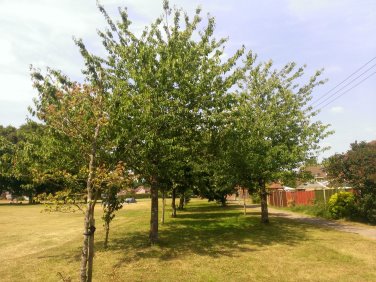 Prunus avium - Wild cherry is a medium-sized tree with a rounded crowm - when grown in the open - as in this photo - these wild cherry trees are planted in a park - it takes on a sturdy spreading habit - when found in its more usual woodland habitat, it is more often slender with long, reaching, whippy branches.
Prunus avium - Wild cherry is a medium-sized tree with a rounded crowm - when grown in the open - as in this photo - these wild cherry trees are planted in a park - it takes on a sturdy spreading habit - when found in its more usual woodland habitat, it is more often slender with long, reaching, whippy branches.
The leaves are oval with toothed margins and in early spring, the tree is covered with abundant blooms - white to very pale pink and slightly fragrant.
A Closer Look
The fruits, which ripen in mid summer, are small - up to about 1cm in diameter, hard until fully ripe and sour to the taste even then.
They are somewhat variable - some trees will produce fruit that are little more than a stone with a thin layer of skin over it, others are more recognisably cherries - with juicy red or yellow flesh (but almost invariably still very sour).
 You may also sometimes find feral cherries - that is, the chance offspring of cultivated varieties of cherry - perhaps grown from a stone that someone discarded into a hedgerow, perhaps stolen and dropped by a bird.
You may also sometimes find feral cherries - that is, the chance offspring of cultivated varieties of cherry - perhaps grown from a stone that someone discarded into a hedgerow, perhaps stolen and dropped by a bird.
Feral cherries will often retain a little of the character of their cultivated parent - that is, larger, sweeter fruit and perhaps a different colour from the standard orange-red.
Once, on a camping trip to Yorkshire, I discovered a feral cherry tree heavy with perfect, large, dark purple fruit- the tree was growing alongside a layby on a quiet country road - obviously, grown from a seed discarded from someone's picnic lunch many years previously. picked several pounds of big, sweet, juicy cherries - they were delicious!
 Sometimes, you'll find the cherry tree, but it won't seem to have any fruit on it, even in season - but often if you get underneath it and look up through the canopy, you'll see what you were missing on first glance.
Sometimes, you'll find the cherry tree, but it won't seem to have any fruit on it, even in season - but often if you get underneath it and look up through the canopy, you'll see what you were missing on first glance.
Unlike cultivated cherries, the fruits tend to ripen progressively over the space of a few weeks - in a way, this is good - because you're more likely to find them, but it does also mean you're not ever likely to pick a lot in one place.
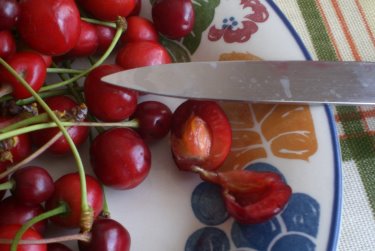 From wild-growing and planted wild cherry trees within walking distance of home, I managed to pick a good double handful of cherries.
From wild-growing and planted wild cherry trees within walking distance of home, I managed to pick a good double handful of cherries.
Even the sweetest, juiciest one of them was extremely sour - but quite aromatic. I decided to make cherry brandy.
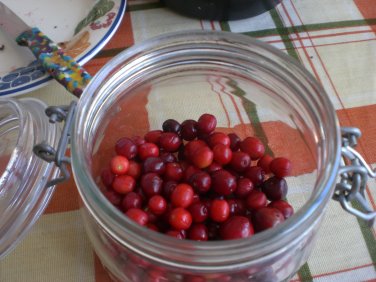 I removed the stalks and scored the cherries around their equators with a sharp knife, then put them in a preserving jar.
I removed the stalks and scored the cherries around their equators with a sharp knife, then put them in a preserving jar.
To this, I added about 500ml of Spanish brandy and half a cup of white sugar, then sealed down the lid and shook it up.
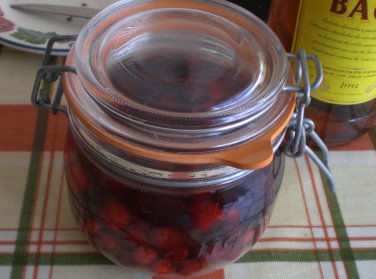 I'd have liked to use a few more cherries even for this small amount of brandy - so I left a bit of headspace in the jar. Over the next week or so, I'll pick more wild cherries and add them in.
I'd have liked to use a few more cherries even for this small amount of brandy - so I left a bit of headspace in the jar. Over the next week or so, I'll pick more wild cherries and add them in.
Once the first lot of sugar has dissolved, I'll add another half cup - cherry brandy should be sweet - and the mixture needs to be syrupy enough to draw the juices out of the cherries.
I'll leave the fruit to soak for a couple of months at least, then I'll strain it off into little bottles - I'm going to save it to drink at Christmas.
Finding Wild Cherries
The fruits of the wild cherry, although bright red, are not always very conspicuous. Here are some tips on how to locate the trees (some of them require patience!
The Bark
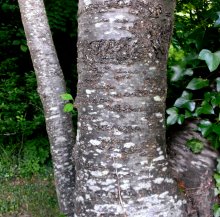 The bark of wild cherry trees is slightly glossy silver-grey, sometimes with a purplish-bronze hue and has distinctive, horizontal raised streaks of rough, corky brown.
The bark of wild cherry trees is slightly glossy silver-grey, sometimes with a purplish-bronze hue and has distinctive, horizontal raised streaks of rough, corky brown.
In Spring
Look out for the blossom - White to pale pink, falling like snow in the woods in spring (NB: there are other relatives of the cherry - notably the Cherry Plum and Blackthorn - that produce similar blossom at the same time - but these are also good wild foods, so finding those won't be a disappointment.
Make a note of where you saw the blossom and return back there in summer for the fruit.
Look On The Ground
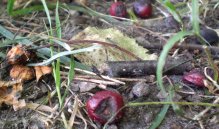 When wild cherries are in full fruit, birds will be visiting the tree to eat them - the ground beneath the tree may become quite conspicuously covered with half-eaten fruit.
When wild cherries are in full fruit, birds will be visiting the tree to eat them - the ground beneath the tree may become quite conspicuously covered with half-eaten fruit.
As is very often the case with foraging for things that grow on trees, the very best specimens are just out of reach - the temptation is to return with hooks and ladders, but I prefer to just visit more trees, pick those that I can reach and leave the higher-hanging fruit for the birds.
